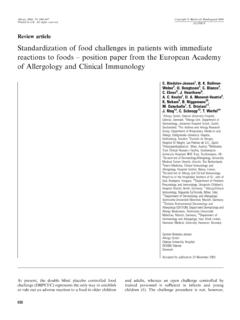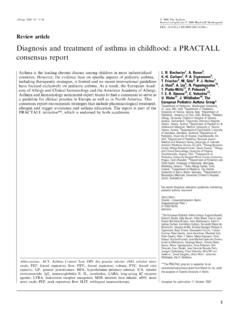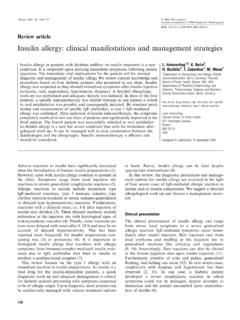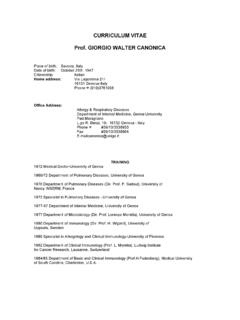Transcription of The history of the idea of allergy - EAACI.org
1 REVIEW ARTICLEThe history of the idea of allergyJ. M. IgeaCl nica Alergoasma, Salamanca, SpainTo cite this article:Igea JM. The history of the idea of ;68: 966 ; anaphylaxis; history ; hypersensitivity; Juan M. Igea, Cl nica Alergoasma,c/Pinto, 2-18, bajo, 37001 Salamanca, : +34 923 264 061E-mail: for publication 24 March 2013 by: Thomas BieberAbstractAbout 100 years ago, a young paediatrician understood that the function of theimmune system should be rationalized not in terms of exemption of disease butin terms of change of reactivity. He coined a new word to represent such an idea: allergy : the first contact of the immune system with an antigen changes the reac-tivity of the individual; on the second and subsequent contacts, this change (orallergy) can induce a spectrum of responses from protective (literally, immune) tohypersensitivity ones. The idea was at first hardly understood by the scientificcommunity because it undermined the essentially protective nature of the immuneresponse as it was defined.
2 Nevertheless, in the next years, the growing clinicalevidence led to the acceptance of this new point of view, but not of the newword, at least not unconditionally. The original significance of the neologism allergy became perverted and limited to describe hypersensitivity conditions. Per-haps because of the corruption of the term, today allergy does not have a well-delimited significance among health professionals. Furthermore, the word haslong ago escaped from physicians and gone to the streets, where it is popularlyused also as synonymous with antipathy and rejection. This vulgarization of theterm allergy has significantly increased its the idea of allergy and the word itself are fundamentalaspects of the medical discipline of clinical immunology. Theterm constitutes the prefix of other important medical wordsand has actually given its name to an entire medical spe-cialty.
3 But, despite the worthy efforts of eminent authorssuch as Samter (1), Silverstein (2), Simons (3), Kay (4), Jack-son (5), Jamieson (6), and others in reviewing its history andmeaning, few allergists and clinical immunologists knowthem. Perhaps it would be a good moment to ask ourselves,is it possible to know where we are going if we ignore wherewe come from?Given the unconstructive impact of a negative answer, andin order to fill this gap in our knowledge, we propose toreview in detail the origin and evolution of this importantidea. We hope that this knowledge will provide all profes-sionals interested in what now is known as allergic diseases with the background necessary to advance in clinical andresearch the late nineteenth and early twentieth centuries, a notablegroup of scientists led by Louis Pasteur, Paul Erhlich, ElieMetchnikoff, Jules Bordet y Emil A. Von Behring describeda novel system whose function was to defend the body fromattacks by microorganisms.
4 They called it the immune system(literally, a system that exempts from the disease). Theimmunity provided by this system entailed an absolute pro-tection against a noxious agent, or at least the occurrence ofsome process strictly advantageous to the host. Nobodycould imagine then that it could harm the host it , the process of industrialization of Europe andNorth America and the new antitoxin parenteral treatmentsand vaccines caused new diseases and strange reactions thatphysicians could not explain. Few ones were able to suspectthe implication of immune system in these new disorders,and the Viennese paediatrician Clemens von Pirquet Freiher(Fig. 1), more interested in his patients clinical problemsthan in laboratory experiments, was one of the first to stateclearly this idea first came to von Pirquet when he was a paediatricresident at the Universit ats KinderKlinic in Vienna.
5 Hethought that the immune system played a role in the patho-physiology of infectious diseases and determined the patentlesions of the disease, or at least a large part of them, apartfrom the evident role of microorganisms and their toxins. On 2 April 1903, and in collaboration with his co-worker BelaSchick, von Pirquet wrote a preliminary report of his theoryAllergy68(2013) 966 973 2013 John Wiley & Sons A/S. Published by John Wiley & Sons Ltd966entitledZur theorie der infektionskrankheiten( On the theoryof infectious disease ) and put it in a sealed envelope that wasdeposited in the Imperial Academy of Sciences in Vienna inorder to establish priority. His caution advised him to delay itspublic reading to allow him to further develop his contained a revolutionary idea: the cardinal signs of dis-eases caused by infections were not only the result of the actionof microorganisms and their toxins, but also the body sresponse (antibody) against them (7).
6 The strongest evidencesupporting this theory was the resemblance between manyspontaneous and experimental diseases of external origin inincubation time and disease manifestations. The incubationtime was the time that elapses before the formation of anti-body. The idea implied that immune system, a system essen-tially protective, could harm the host that housed von Pirquet did not wait very long to publish his newtheory. On June 25 in the same year, the French immunolo-gist Nicolas Maurice Arthus published an eye-opening experi-ment (8): after the fourth subcutaneous injection of horseserum in rabbits, a local oedematous reaction occurred; afterthe fifth, it became purulent; and after the seventh gangre-nous. In other words, an increased specific sensitivityfollowed repeated injections of a foreign protein that was pri-marily nontoxic. More importantly, Arthus recognized therelationship of the increased sensitivity with the anaphylaxisof Charles Richet, published the year before (see below) (9).
7 This observation spurred von Pirquet and Schick to publishonly 9 days later, on July 4, their preliminary note on infec-tious diseases (10).Over the next 2 years, von Pirquet and Schick extendedtheir work to a common systemic complication appearing8 12 days after some children received a first dose of an anti-serum which they named serum sickness (or disease causedby the serum ). Antitoxic sera were introduced in therapeuticsin 1891 by von Behring and Kitasato and systemic complica-tions quickly appeared that were interpreted as the results ofseveral nonimmune causes. Von Pirquet and Schick reachedanother interpretation and concluded that serum sicknesswas due to a hypersensitivity reaction provoked by antibod-ies to the antitoxin. As in their earlier study of the incubationtime of infectious diseases, they focused on the time factor ,that is, the interval between the first injection and the onsetof serum sickness or time necessary to produce the antibod-ies, which was accelerated after repetition of the serum sickness was induced by the collision of antigenand antibody.
8 All these ideas were discussed in depth in thebookDie Krankheit Serum( the serum sickness ) published in1905 (11).Apart from the above-mentioned experiments performedby Arthus and Richet, other experimental observationshelped to shape the new ideas of von Pirquet. In 1903, Ham-burguer and Moro found precipitating antibodies in humanblood following the administration of antisera. TheobaldSmith noted in 1903 that guinea pigs used to standardizediphtheria toxin (injected with mixtures of toxin and horseserum) often died when injected several weeks later with nor-mal horse serum; one year later, Paul Ehrlich put R. Otto towork in what he termed the Theobald Smith phenomenon (12). In 1906, Milton Rossenau and John Anderson (13), inan attempt to understand the cause of the adverse reactionsof some patients to diphtheria antitoxin, studied the effect ofrepeatedly injecting horse serum into guinea this point, it became clear to von Pirquet that the exist-ing terminology was inadequate.
9 The concept of immunityproceeded of a time when nothing was known about hyper-sensitivity and when the immune system was consideredpurely protective. It was necessary to start again from thebeginning. So, von Pirquet further developed his theory andpublished it in 1906 in a now classic article of just two pagesentitledAllergie(14). In it, he gave reasons to explain his the-ory and proposed the new terminology, the germinal theoryof allergy (Fig. 2). He noted that the exposure of the body toa substance resulted in the production of antibodies thatinduced a change in subject-specific reactivity to the sub-stance to which he called allergy (from the Greekallos,meaning other or different , andergia, meaning energy oraction , in the sense of change in reactivity or capacity toreact ). Such change could be protective, so that the subjectdoes not manifest symptoms in response to that substance( a real immune response, in the etymological and originalsense that such a term had at first, the exemption of theFigure 1 Clemens von Pirquet (1874 1929), creator of the idea ofallergy.)
10 The photograph was taken in 1906, the same year that hepublished his seminal article explaining his idea of allergy and pro-posing a new terminology. Von Pirquet worked on his theory ofallergy only between 1903 and 1911, although in 1927 he publisheda final review on the subject. Photograph from the O sterreichischeGesellschaft fu r Allergologie und years later, on 13 February 1908, von Pirquet requested that theenvelope be opened and the contents read. This was done at a meeting ofthe Academy s Division for Mathematics and Natural (2013) 966 973 2013 John Wiley & Sons A/S. Published by John Wiley & Sons Ltd967 IgeaHistory of the idea of allergydisease) or be harmful and cause symptoms and signs of theillness (in the sense of hypersensitivity). Then, immunity (pro-tective) and hypersensitivity (harmful) were two ends of thesame physiological process (the response of the host immunesystem or allergy ) and not exclusive.













